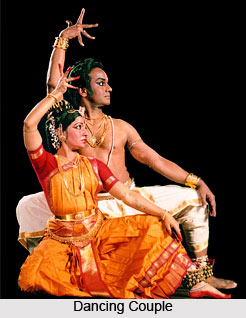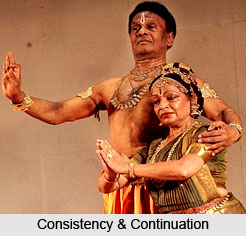Raja and Radha Reddy, the dancing duo is estimated as the world-renowned dancing couple, who has given a new magnitude to the age-old art of Kuchipudi dance. With keeping the traditional poetry or dramatic aesthesia, as it was prevalent, they tried to give an enormity to the dance form. Today their rare excellence and flawlessness of the technique, made them stand tall on the highest stage of Kuchipudi. They originally hail from the state of Andhra Pradesh, which is considered to be the birthing place of Kuchipudi style of Indian classical dances.
Raja and Radha Reddy impersonates the masculine dynamism and lyrical magnetism of the classical pairs of Hindu mythology, through their affectionate closeness and perfect harmony. Lord Shiva-Parvati, Lord Rama-Sita and Lord Krishna-Radha are some of the items they portray in this manner, which has received a rave response from the audiences. Through these mythological characters, they incorporate the twin concept of Purusha and Prakriti, the male-female principle in Indian philosophy. The duo re-invigorates the splendid sculptures, which are butted in the ancient temples of India in every accurate posture and elaborated pattern of their dance.

International Tours of Raja and Radha Reddy
The Kuchipudi style of dance has been propagated by the performance of Raja and Radha Reddy all over the world. Their most of the performance took place under the invitation made by various government and cultural institutions. One of the most unforgettable performances ever by the Reddy`s was at New Orleans. They performed in front of the President of United States of America, Mr. Gerald Ford. At New Orleans, they performed on board a barge.
Their performance in Cuba was another vividly remembered moment. Two of the most important production of this duo are: `Parampara`-it is a production in which they tried to interpret the subtle nuances of the Indian classical Dance form; `Natyam`-creative interpretation of the aesthetical matrix of the cadenced rhythm of in the multilayered edifice of Indian Dance tradition. Others are `Ananya` and `Life Tree`.
In July 1996, the All Star Ballet Gala festival was held at Japan and Raja and Radha Reddy were the star attraction of the festival. Raja and Radha Reddy were invited at Bangladesh in November 1996 to inaugurate the India Festival. They toured Europe and the US in the respective years of 2001 and 2003. They received an overwhelming response throughout their tour. Each performance of theirs achieved an enthusiastic recognition from the audience. In the illustrious Edinburg Festival held in the year 2002, they were also featured as star performers.

Raja and Radha ReddyRaja-Radha Reddy have excogitated a syllabus for the entire range of Kuchipudi dance by codifying the basic movements and mudras of the art form. Through their performances, which they have choreographed, they have always attempted to make each and every Kuchipudi classical dance form acceptable to modern cosmopolitan audiences. Raja-Radha Reddy both are endlessly striving to disseminate music and dance among the arising younger generation. Raja and Radha Reddy have bought the Kuchipudi Dance through their academy `Natya Tarangini` to the cultural map of the world. They also inspired and supported their two daughters -- Yamini and Bhavana to this dance form. Yamini and Bhavana both have received accolades on their own as dancers.
Philanthropic Initiative by Raja and Radha Reddy
Apart from dancing in a professional manner, they have also carried on charity shows for Red Cross Society, Blind Relief Association and the home for the aged people in Bombay and CRY. They have also bagged the honour of being called for as the first Indian dancers to partake in the International Dance festival of Avignon in France and Salzburg in Austria.
Awards Received by Raja and Radha Reddy
Raja and Radha Reddy are majestic acquirers of many National and International awards and titles. They were given these accolades for their outstanding contribution to the field of Kuchipudi Classical Dance. They were regarded as the first couples, to receive the Padam Shri and Padma Bhushan award individually and together. International Meridian Award and the Sangeet Natak Academy Award have also been conferred to them for their quality of talent.



















